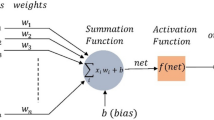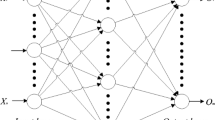Abstract
This paper deals with the parallel layer perceptron (PLP) complexity control, bias and variance dilemma, using a multiobjective (MOBJ) training algorithm. To control the bias and variance the training process is rewritten as a bi-objective problem, considering the minimization of both training error and norm of the weight vector, which is a measure of the network complexity. This method is applied to regression and classification problems and compared with several other training procedures and topologies. The results show that the PLP MOBJ training algorithm presents good generalization results, outperforming traditional methods in the tested examples.



















Similar content being viewed by others
References
Bartlett PL (1998) The sample complexity of pattern classification with neural networks: the size of the weights is more important than the size of the network. IEEE Trans Inf Theory 44(2):525–536
Caminhas WM, Vieira DAG, Vasconcelos JA (2003) Parallel layer perceptron. Neurocomputing 55(3–4):771–778
Chinrungrueng C, Séquin CH (1995) Optimal adaptive k-means algorithm with dynamic adjustment of learning rate. IEEE Trans Neural Netw 6:157–169
Cortes C, Vapnik V (1995) Support vector networks. Mach Learn 20:273–279
Costa MA, Braga AP, Menezes BR, Teixiera RA, Parma GG (2003) Training neural networks with a multi-objective sliding mode control algorithm. Neurocomputing 51:467–473
Duda RO, Hart PE (1973) Pattern classification and scene analysis. Wiley-Interscience, New York
Fahlman SE, Lebiere C (1990) The cascade-correlation learning architecture. In: Touretzky D (ed) Advances in neural information processing systems, vol 2. Morgan Kaufmann, San Mateo
Geman S, Bienenstock E, Doursat R (1992) Neural networks and the bias-variance dilemma. Neural Comput 4(1):1–58
Hangan MT, Menjah MB (1994) Training feedforward network with the Marquardt algorithm. IEEE Trans Neural Netw 5(6):989–993
Ismail MA, Kamel MS (1989) Multidimensional data clustering utilizing hybrid strategies. Pattern Recognit 22:75–89
Ismail MA, Selim SZ, Aror SK (1984) Efficient clustering of multidimensional data. In: Proceedings of the IEEE international conference on systems man and cybernetics, pp 120–123
Kearns MJ, Schapire RE (1990) Efficient distribution-free learning of probabilistic concepts (Abstract). In: COLT ’90: Proceedings of the 3rd annual workshop on computational learning theory
Lacerda E, Carvalho A, Braga AP, Ludermir TB (2005) Using evolutionary RBF networks for credit assessment. Appl Intell 22(3):167–182
Llyod SP (1982) Least squares quantization in pcm. IEEE Trans Inf Theory 28(2):129–137
MacQueen J (1967) Some methods for classification and analysis of multivariate observations. In: Proceedings of the 5th Berkley symposium mathematical statistics and probability, vol 1, pp 281–297
Parekh R, Yang J, Honavar V (1987) Constructive neural network learning algorithms for multi-category real-valued pattern classification. Technical report, Iowa State University, Department of Computer Science
Sexton R, Dorsey R (2000) Reliable classification using neural networks: a genetic algorithm and backpropagation comparison. IEEE Trans Knowl Data Eng 30:11–22
Shawe-Taylor J, Bartlett PL (1998) Structural risk minimization over data-dependent hierarchies. IEEE Trans Inf Theory 44(5):1926–1940
Shor NZ (1977) Cut-off method with space extension in convex programming problems. Cybernetics 12:94–96
Takahashi RH, Peres PLD, Ferreira PAV (1997) H2/h-infinity multiobjective pid design. IEEE Control Syst 15(5):37–34
Teixeira RA (2001) Treinamento de Redes Neurais Artificias Atraves de Otimizatpo Multi-Objetivo: Uma Nova Abordagem para o Equilibro entre a Polarizacao e a Variancia. PhD Thesis, CPDEE- UFMG
Teixiera RA, Braga AP, Takaha R, Saldanha RR (2000) Improving generalization of MLPs with multi-objective optimization. Neurocomputing 35:189–194
Vapnik VN (1998) Statistical learning theory. Wiley, New York
Vapnik VN (2001) The nature of statistical learning theory, Statistics for Engineering and Information Science, 2nd edn. Springer, Berlin Heidelberg New York
Yao X (1993) a review of evolutionary artificial neural networks. Int J Intell Syst 8:539–567
Acknowledgments
This work was supported by CNPq (grants no. 350902/1997-6, no. 140009/2004-3), CAPES-COFECUB Project Cooperation no. 318/00-II and CAPES (grant no. 3421/04-0), Brazil.
Author information
Authors and Affiliations
Corresponding author
Rights and permissions
About this article
Cite this article
Vieira, D.A.G., Vasconcelos, J.A. & Caminhas, W.M. Controlling the parallel layer perceptron complexity using a multiobjective learning algorithm. Neural Comput & Applic 16, 317–325 (2007). https://doi.org/10.1007/s00521-006-0052-z
Received:
Accepted:
Published:
Issue Date:
DOI: https://doi.org/10.1007/s00521-006-0052-z




